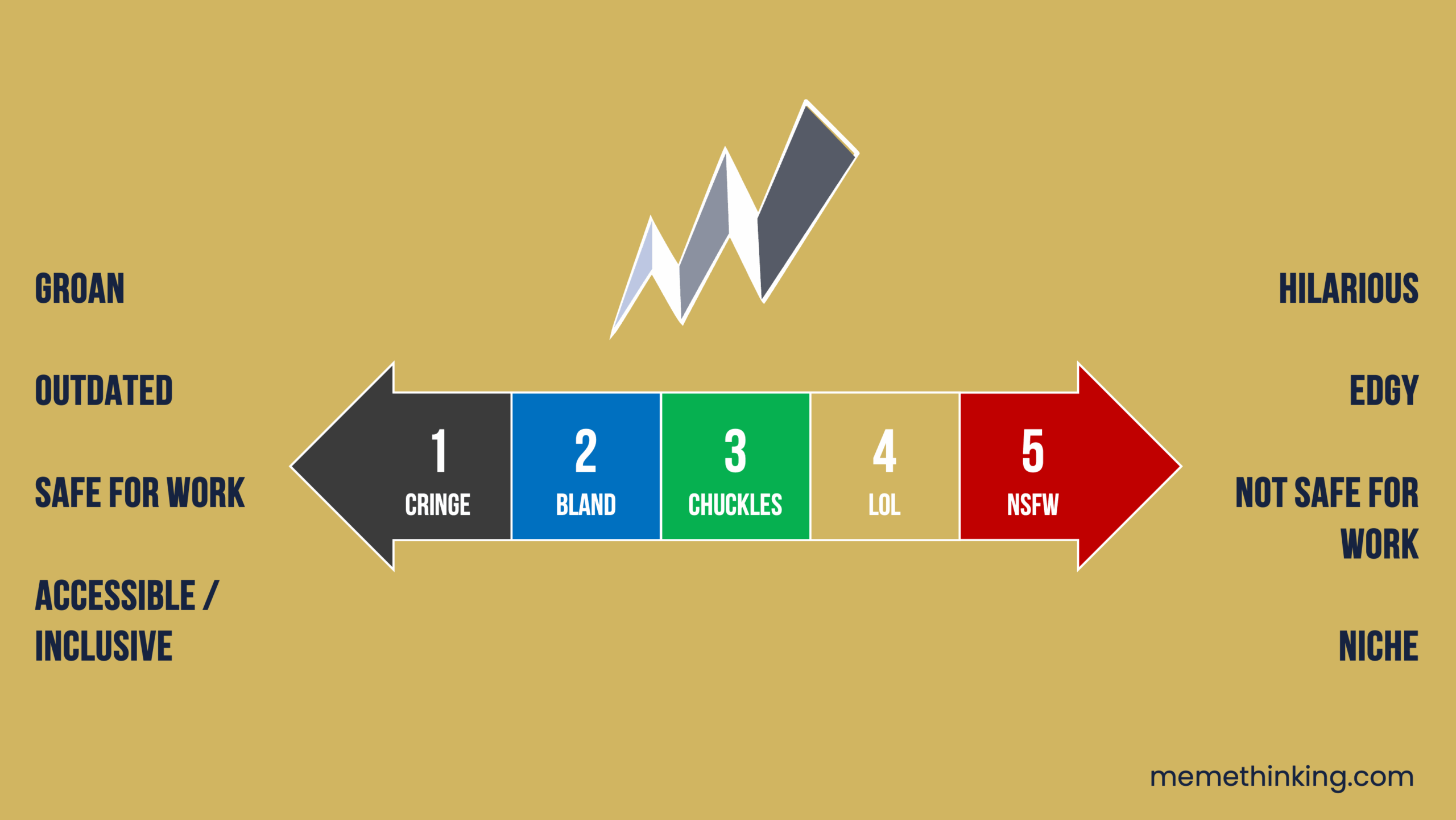In today’s hybrid and emotionally nuanced workplaces, humour isn’t just a way to lighten the mood—it’s a strategic communication tool. But when memes, jokes, or pop culture references go wrong, the fallout can range from awkward silence to disciplinary action. That’s where the Meme Thinking Cringeometer comes in: a simple, psychologically-informed scale to help teams calibrate humour in the workplace for the right context, the right audience, and the right level of hilarity.
Two Axes of Workplace Humour
To understand how the Cringeometer works, we need to start with the foundational insight from the first model (see image above): humour in the workplace exists across two intersecting spectrums:
- Funny to Not Funny
- Safe for Work (SFW) to Not Safe for Work (NSFW)
These two spectrums often—but not always—align. For instance:
- A dad joke might be totally safe, but land so flat it’s barely a chuckle.
- An edgy meme might be hilarious in a private group chat, but entirely inappropriate in a town hall presentation.
This disconnection between humour and safety is what makes humour in professional settings so tricky. Often, the safer a joke is, the less funny it becomes—yet funny doesn’t have to mean fired.
Enter: The Cringeometer
The Meme Thinking Cringeometer is a five-point scale that helps teams navigate this complexity:
| Rating | Description |
|---|---|
| 1 | Cringe – Groan-worthy, outdated, painfully generic (e.g., “Monday again?”) |
| 2 | Bland – Safe, but lacking flavour; corporate email banter |
| 3 | Chuckles – Light, relatable humour that most people can appreciate |
| 4 | LOL – Edgy, surprising, possibly niche, but still context-aware |
| 5 | NSFW – Hilarious in the right group chat; dangerous elsewhere |
The Cringeometer helps us move away from a binary view of humour (funny or inappropriate) to a sliding scale that balances hilarity, edginess, safety, and audience.
How to Make Unfunny Jokes Funnier
Even a “Cringe” or “Bland” joke can be redeemed with some smart delivery tactics:
- Use it ironically – “Yes, I am going to make a ‘dog ate my work’ joke in 2025.”
- Break the fourth wall – Acknowledge that the joke is bad as you tell it.
- Subvert old tropes – “There are 10 types of people in the world… and I’m not explaining this joke again.”
- Contextualise it – Add a layer that makes it specific to your audience’s shared experience or pain point.
These approaches tap into the psychology of shared meaning and meta-awareness, which research shows can enhance humour and social bonding (Martin & Ford, 2018).
How to Make Edgy Jokes Safer
If you’re hovering around the LOL/NSFW zone, you don’t have to ditch your wit entirely. Try moderating the delivery:
- Make it self-deprecating – If the joke’s at anyone’s expense, make sure it’s yours.
- Let the audience finish it – Implication makes people complicit, and it feels less aggressive.
- Adapt niche humour – Take a deep-cut meme and broaden it just enough to let others in.
- Know your audience – Humour is riskier with big, diverse groups. But in a close-knit team? You’ve got more leeway.
These tactics build on humour’s ability to defuse tension, signal humility, and encourage connection, as shown in psychological studies of workplace wellbeing (Mesmer-Magnus et al., 2012).
When in Doubt: Aim for Chuckles
In the corporate wild, Chuckles (3) is your home base. It’s:
- Safe enough to keep HR happy
- Specific enough to be relatable
- Funny enough to break the ice
When presenting to a large audience or cross-functional group, it’s usually best to stay at levels 2–3 on the Cringeometer. If you know your team well and the setting is informal, you can lean into level 4. Level 5? That’s after-work drinks or private Slack threads—with clear consent and context.
Ironically, even dad jokes can live in the Chuckles zone—if you lean into the cringe. That meta-awareness adds a layer of playfulness, shifting the joke from bland to knowing.
Why This Matters
Humour isn’t just about laughs—it’s about emotion, identity, and inclusion. In a meme-saturated world, learning to read the room (and the meme) is a form of emotional intelligence. The Cringeometer is a shared language that teams can use to play, connect, and communicate more effectively—without crossing the line.
So next time you’re about to drop that spicy meme in a presentation or hit “send” on a reaction GIF, pause. Ask yourself: where does this sit on the Cringeometer?
And remember—cringe is a feature, not a bug. If you do it right.
References
Martin, R. A., & Ford, T. (2018). The psychology of humor: An integrative approach (2nd ed.). Academic Press.
Mesmer-Magnus, J., Glew, D. J., & Viswesvaran, C. (2012). A meta-analysis of positive humor in the workplace. Journal of Managerial Psychology, 27(2), 155–190. https://doi.org/10.1108/02683941211199554

